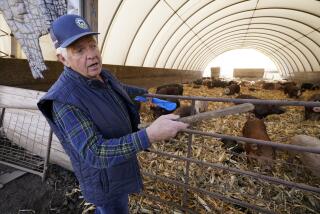No Longer Living High on the Hog, Upset Farmers Start Giving Pigs Away
When Don Brady decided to call it quits as a hog farmer, he did not go quietly. He had always enjoyed this life, he had always been a success. So when low prices squeezed him out, he went public.
âFree hogs,â declared the small ad he placed in his local newspaper. âWhen the cost of a 10-pound ham is more than a farmer gets for his whole hog, itâs time to give them away.â
And so he did.
In late December, folks lined up in cars and trucks in 20-degree cold the night before the giveaway, waiting to take him up on his one-animal-per-family offer. He handed out 60 hogs in one day at his farm in Neponset, in west-central Illinois.
âIt was the last hurrah,â says the 49-year-old Brady, who has tended hogs since he was a fresh-faced teenager in a 4-H Club. âThis was a way to do some good for needy families and to make a statement about what has happened to the farmer.â
What has happened is nothing short of a disaster.
Hog prices have plunged to record lows, forcing some farmers to quit and pushing others deeper in debt, wondering if they will ever dig out. Some have lost $2,000 a day, or two yearsâ income in two months.
âIt is catastrophic,â says Chris Hurt, agricultural economist at Purdue University. âItâs Depression-era. It is really without comparison.â
Hog farmers lost about $2.6 billion in 1998, based on an average loss of $27 per animal, says Ron Plain, a livestock specialist at the University of Missouri.
And though prices have rebounded slightly in recent weeks, no one expects a rapid reversal of fortune.
In fact, Plain predicts that hog farmers could lose $1.5 billion more by midsummer, when he expects they will break even.
The reason for the hog crisis is fairly simple: Too many animals, too few slaughtering operations.
Oddly enough, prosperity is partly to blame.
Hog farming was booming in 1996 and 1997, so producers began raising more animals. âWhen you make money, itâs natural for people to want to reinvest, and thatâs what happened,â Plain says.
Some also blame the growth of huge corporate hog farms that have come under increasing regulation by states because of air- and water-pollution problems.
âThere was a mad rush to find sites before there were further environmental restrictions,â Hurt says. Some states imposed moratoriums.
In 1998, hog production was up 10% over the last year, but packing-plant capacity fell by 8%. Three big older slaughterhouses closed in the last two years.
âPackers found it didnât matter how low they bid for hogs, there still were plenty of them lined up at the door each day,â Plain says.
Hog prices fell from 55 cents a pound two years ago to as low as 8 cents a pound in late 1998, he says.
Farmers who spent $100 to raise a hog sold their animals for $20 each. And they had no choice. Unlike grain that can be stored until prices rebound, hogs are perishable.
âYou canât say, âThe market is terrible today,â â Plain says. âWhen theyâre grown up and ready to go, theyâve got to go.â
At the same time, the cost of pork at the grocery store barely changed in the last year, prompting accusations of gouging.
Agriculture Secretary Dan Glickman has asked for a federal probe into possible price-fixing, even as farmers and some economists have raised questions about consumer costs. His own agency is conducting an internal probe of the price spread between the farm, wholesale and retail level and packersâ pricing practices.
But Plain argues that making pork cheaper in the supermarket would not have rescued farmers.
âOne would expect that if you cut the price, demand would increase for pork, and hog prices would go up,â he says. âNormally, thatâs how it works--unless you have inadequate capacity somewhere down the line. And thatâs what we had.
âIf you cut the price . . . packers couldnât kill any more hogs than they were killing,â he adds.
Thatâs little solace for farmers, who have become increasingly frustrated. One Iowa producer planned a pig hunt on his land to call attention to the crisis, but canceled the event.
Concern also has spread to the nationâs capital, where experts testified at a recent congressional hearing that prices would soon stabilize. That same day, nearly a dozen hog producers met with President Clinton to describe their dire straits.
Across the Midwest, there are countless tales of financial ruin.
âI told my kids Iâve got a job, but I donât have a paycheck,â says an exasperated Ron Mohr, an Iowa hog farmer for 34 years who gave away 27 of his animals in November.
âI lost $25,000-$30,000 in operating income in four months,â he says. âThereâs no question we canât continue this way very long.â
Plain, the Missouri economist, says a third to a half of the nationâs 114,000 hog producers are likely to quit unless thereâs a major government bailout.
Vice President Al Gore has announced that hog producers will get $50 million in direct payments from the government. The government also announced that it would buy $50 million worth of pork for the federal food assistance program.
State governments too are pitching in. In Illinois, farmers will have access to low-interest loans, and state agencies have been ordered to buy more pork for state prisons and mental institutions.
Meanwhile, pork producers remain in a quandary.
âFarmers donât know what to do. Itâs out of their control,â says James Quackenbush, president of the Minnesota Pork Producers Assn. âThey donât have any other way to go but to get out, and most donât want to do that. Theyâve invested a lot of years and a lot of money in their operations.
âIn some cases, you canât quit,â adds Quackenbush, a fourth-generation farmer who raises hogs with two brothers in west-central Minnesota. âYou have a mortgage on that building. Youâre losing money, but you keep going in hopes that you can get better.â
Thatâs what Tim Donlon is banking on to save the only career heâs had in his 36 years.
âWe ask ourselves every day, âWhat if this doesnât turn around? What will we do?â There isnât a right answer. I could wake up tomorrow and say, âIâve had it,â â says Donlon, who farms amid the rolling hills of northeast Iowa, 10 miles from the Mississippi River.
In one year, the value of his sows dropped from $30,000 to $5,000.
That has left him juggling bills, delaying payments and worrying about borrowing more money from the bank.
âInstead of making $40,000 . . . I lost $40,000,â Donlon says, frustration creeping into his voice. âI worked as hard as I did any other year and Iâve got nothing to show for it.â
In recent weeks, the hog glut has diminished slightly; cold weather slows the animalsâ growth.
But itâs too late for Don Brady.
He says his grain crop will offset some of his losses, but he will end up in the red. He still has some hogs to sell, but after that, he will be out of the business.
âIt was a tremendously tough decision,â says Brady, who followed in his fatherâs footsteps and had planned for his son to continue the family tradition. âI love the job. Itâs like some people grow up to be firemen or lawyers. We grew up to be hog farmers.â
But farming, he says, is a gamble, and heâs not bitter he lost.
âWhen it becomes spring, weâll all get spring fever,â he says. âThen weâll turn a new chapter and do something else.â
More to Read
Sign up for Essential California
The most important California stories and recommendations in your inbox every morning.
You may occasionally receive promotional content from the Los Angeles Times.










